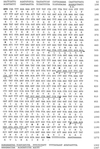Cloning, nucleotide sequencing, and analysis of the gene encoding an AmpC beta-lactamase in Acinetobacter baumannii
- PMID: 10639377
- PMCID: PMC89698
- DOI: 10.1128/AAC.44.2.428-432.2000
Cloning, nucleotide sequencing, and analysis of the gene encoding an AmpC beta-lactamase in Acinetobacter baumannii
Abstract
A clinical strain of Acinetobacter baumannii (strain Ab RYC 52763/97) that was isolated during an outbreak in our hospital and that was resistant to all beta-lactam antibiotics tested produced three beta-lactamases: a TEM-1-type (pI, 5.4) plasmid-mediated beta-lactamase, a chromosomally mediated OXA-derived (pI, 9.0) beta-lactamase, and a presumptive chromosomal cephalosporinase (pI, 9.4). The nucleotide sequence of the chromosomal cephalosporinase gene shows for the first time the gene encoding an AmpC beta-lactamase in A. baumannii. In addition, we report here the biochemical properties of this A. baumannii AmpC beta-lactamase.
Figures


References
-
- Bergogne-Bérézin E. The increasing significance of outbreaks of Acinetobacter spp.: the need for control and new agents. J Hosp Infect. 1995;30:441–452. - PubMed
MeSH terms
Substances
Associated data
- Actions
LinkOut - more resources
Full Text Sources
Other Literature Sources
Molecular Biology Databases
Research Materials
Miscellaneous

